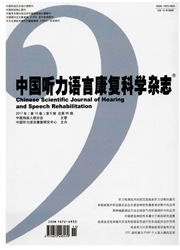

 中文摘要:
中文摘要:
目的通过对澳大利亚Nucleus(直电极和弯电极)、奥地利Medel和美国Advanced Bionics人工耳蜗不同电极植入者开机后的调试情况,以及听觉和言语康复效果进行观察比较,探讨不同植入电极患者术后效果是否存在差异。方法我科自1997年3月至2007年6月共植入人工耳蜗313例,选择其中植入年龄、植入时间、术前残余听力、术后康复条件等各方面条件相近的语前聋人工耳蜗植入者70例,将其按植入产品的不同分为4组,包括澳大利亚Nucleus直电极组22人,澳大利亚Nucleus弯电极组25人,奥地利Medel C40+组12人和美国AB公司90K组11人。比较4组人工耳蜗植入患者开机半年后的阈值(T-levels).最大舒适强度(C-levels/M-levels)和动态范围(dynamic range)有无差异,并根据听觉行为分级标准(categories of auditory performance,CAP)和言语可懂度分级标准(speech intelligibility rating,SIR)对4组人工耳蜗植入者进行评估,用统计学方法分析不同电极人工耳蜗植入者听觉水平和言语可懂度康复效果是否存在统计学差异。结果经单因素方差分析,4组耳蜗植入者CAP分级和SIR分级得分的差异无统计学意义(P〉0.05)。调试时澳大利亚弯电极组和直电极组的T-levels、C-levels和动态范围大小无统计学差异(P〉0.05);奥地利C40+组与其它三组相比,最大舒适强度和动态范围更大;美国90K组阈值最低,所需刺激量最小。结论人工耳蜗不同电极植入术后均能产生良好效果,其阈值,最大舒适强度和动态范围有差别,但不同植入电极术后的听觉水平和言语可懂度等康复效果无明显差异。
 英文摘要:
英文摘要:
Objective To observe the application of straight and contour electrodes by Cochlear Ltd., Australia, and electrodes by Medel, Austria and Advanced Bionics, USA, and to compare the results of the devices and the outcomes of hearing and speech rehabilitation so that different types of electrodes utilized by cochlear implantations can be thoroughly evaluated. Methods Seventy cochlear implantees were divided into 4 groups: 22 persons with Nucleus CI 24M/CI 24K, 25 persons with Nucleus 24 contour, 12 persons with Medel C40+, and 11 persons with Advanced Bionics 90K. Six months after the turn-on of the implants, the threshold levels(T-levels) ,maximum but comfortable levels(C-levels/M-levels) and dynamic ranges were obtained and compared. The categories of auditory performance (CAP) and the speech intelligibility rating (SIR) were used to evaluate the effects after implantation. Results Statistic analysis had confirmed that the scores of CAP and SIR yielded no significant differences among 4 groups(P〉0.05). Nucleus CI 24M/ Cl 24K and Nucleus 24 contour had no statistical significance in T-levels(C-levels)and dynamic range while Medel C40+ had the highest M-levels and the greatest dynamic range. Advanced Bionics 90K had the lowest T-levels. Conclusion Cochlear implantations with different types of electrodes could have similar effects, however, there are differences in T-levels, C-levels/M-levels and dynamic range. No difference is noted in hearing and speech rehabilitation effects among implantations with different electrodes.
 同期刊论文项目
同期刊论文项目
 同项目期刊论文
同项目期刊论文
 Adenoviral-mediated Hath1-EGFP gene transfer into guinea pig cochlear through an Intact Round Window
Adenoviral-mediated Hath1-EGFP gene transfer into guinea pig cochlear through an Intact Round Window Chondrocyte-specific Smad4 gene conditional knockout resulting in hearing loss and inner ear malform
Chondrocyte-specific Smad4 gene conditional knockout resulting in hearing loss and inner ear malform 期刊信息
期刊信息
